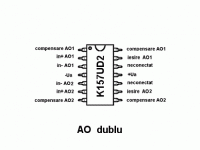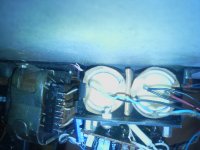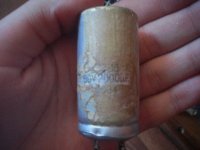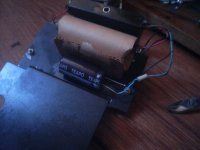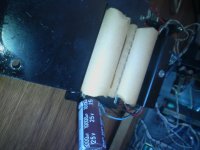Hello everybody, i have an old 12-channel Russian mixer that i'm trying to restore. It is built with K157УД2 ICs which are basically two LM301s slapped in one 14-pin package. The thing does fine with line inputs but with those low sensitivity dynamic mikes i need to turn the trim all the way up and hiss makes its presence felt, especially if i also need a bit of treble boost.
Two of the channels were busted and one had a non-working EQ and i finally decided to fix them today so i picked the TL074 as replacement, the Russian IC isn't pin compatible with anything so if i had to wire it dead bug style anyway it was easier to get it done with ONE chip instead of two. I did one of the channels and it's now working fine, but although in the datasheets the TL074 has the same noise level as the LM301, it has slightly more hiss when used on the mic, but it also gives a bit more gain so it could just be because of that. Anyway, i'm not too happy with the TL074 either.
On a side note, when i rebuilt the headphone amp which was missing parts, i used 2SA733/2SC945 transistors recovered from a monitor, and a lousy 4558C opamp. Well, even with those parts the headphone amp is the quietest thing in the mixer... There's one little detail that i omitted though - the mike input is balanced, but i don't have any balanced mike to test with. Indeed, when i unplug the unbalanced cable the channel goes almost dead silent even with the trim at max. Maybe balanced to unbalanced converters is all it needs?
Oh and i have one more problem with it. Yesterday it suddenly got a rather loud mains hum EVERYWHERE. It turned out that almost all 'lytics on the negative rail got shot somehow. I think i got all the bad ones... I also bumped the main filter caps to 4x 4700uF from 4x 1000uF while i was at it. However, a tiny bit of hum remains (but only audible with the gain maxed with no signal), which goes away if i put a 10000uF cap on the negative rail, but i'm pretty sure this isn't the right way to go about it.
If i disconnect the power to the input channels and leave only the master and headphone amp on the hum goes away. I checked all channels individually and the worst offenders are channels 2, 4 and 5, which is weird since the caps are good, and channel 4 is the one which received the TL074. The voltage on the negative rail is also a bit lower than of the positive, so there's excessive drain somewhere. The voltage also goes to normal if i cut the power to the inputs.
I'll try to lift a schematic of the channel board if i'm not too lazy. In the meantime please suggest some opamps if you wish, but keep in mind that i don't want anything more expensive than a OPA4134, coz besides the two dual opamps on each channel there's seven of 'em on the master as the mixer has a mono monitor bus, reverb input, one aux input, and the stereo headphone output which can take its source from pretty much anywhere, you could use it as an aux bus if you wanted.
That would be 15 quad opamps plus one dual, quite a bunch really. And there's still a lot more stuff it needs, such as some jacks from this century please, and those aren't cheap.
Two of the channels were busted and one had a non-working EQ and i finally decided to fix them today so i picked the TL074 as replacement, the Russian IC isn't pin compatible with anything so if i had to wire it dead bug style anyway it was easier to get it done with ONE chip instead of two. I did one of the channels and it's now working fine, but although in the datasheets the TL074 has the same noise level as the LM301, it has slightly more hiss when used on the mic, but it also gives a bit more gain so it could just be because of that. Anyway, i'm not too happy with the TL074 either.
On a side note, when i rebuilt the headphone amp which was missing parts, i used 2SA733/2SC945 transistors recovered from a monitor, and a lousy 4558C opamp. Well, even with those parts the headphone amp is the quietest thing in the mixer... There's one little detail that i omitted though - the mike input is balanced, but i don't have any balanced mike to test with. Indeed, when i unplug the unbalanced cable the channel goes almost dead silent even with the trim at max. Maybe balanced to unbalanced converters is all it needs?
Oh and i have one more problem with it. Yesterday it suddenly got a rather loud mains hum EVERYWHERE. It turned out that almost all 'lytics on the negative rail got shot somehow. I think i got all the bad ones... I also bumped the main filter caps to 4x 4700uF from 4x 1000uF while i was at it. However, a tiny bit of hum remains (but only audible with the gain maxed with no signal), which goes away if i put a 10000uF cap on the negative rail, but i'm pretty sure this isn't the right way to go about it.
If i disconnect the power to the input channels and leave only the master and headphone amp on the hum goes away. I checked all channels individually and the worst offenders are channels 2, 4 and 5, which is weird since the caps are good, and channel 4 is the one which received the TL074. The voltage on the negative rail is also a bit lower than of the positive, so there's excessive drain somewhere. The voltage also goes to normal if i cut the power to the inputs.
I'll try to lift a schematic of the channel board if i'm not too lazy. In the meantime please suggest some opamps if you wish, but keep in mind that i don't want anything more expensive than a OPA4134, coz besides the two dual opamps on each channel there's seven of 'em on the master as the mixer has a mono monitor bus, reverb input, one aux input, and the stereo headphone output which can take its source from pretty much anywhere, you could use it as an aux bus if you wanted.
That would be 15 quad opamps plus one dual, quite a bunch really. And there's still a lot more stuff it needs, such as some jacks from this century please, and those aren't cheap.
It would be interesting to see the pin-out of the K157.
I would never (ever) use a 07x in an audio circuit. They are like white noise generators. There are so many low cost audio ICs out now (including the 1458 and 4432/4s).
Why not design a small pc board to match the original IC to be soldered into place that allows a standard pin-out IC to be inserted so you can experiment until you find what you need.
I would also strongly recomend that you replace all carbon-film resistors in the audio chain with metal fim resistors!
E
I would never (ever) use a 07x in an audio circuit. They are like white noise generators. There are so many low cost audio ICs out now (including the 1458 and 4432/4s).
Why not design a small pc board to match the original IC to be soldered into place that allows a standard pin-out IC to be inserted so you can experiment until you find what you need.
I would also strongly recomend that you replace all carbon-film resistors in the audio chain with metal fim resistors!
E
'ere you go as requested, pinout of the K157UD2. Some translations are in order: Compensare = Compensation, Iesire = Output, Neconectat = Not Connected, Ua = Vcc.
The TL07x has been recommended to me by someone who worked on all kinds of audio devices, he said that for a cheap opamp it's better than the NE5532 which a lot of people use. I used to use the NE5532 too but i've had trouble with it oscillating especially when replacing 4558 type opamps.
The 1458? Isn't that basicaly a dual 741? Yes it is... 0.5v/us slew rate. No thanks. As for the 4432... if you mean MAX4432, for one i can't find it here, and secondly it isn't appropriate at all for my application. The mixer has +/-15v supplies.
Metal film resistors you say. Yeah that's doable, just a heck of a lot of soldering needed. I'll try to put all 1% resistors when i'll go at it.
The TL07x has been recommended to me by someone who worked on all kinds of audio devices, he said that for a cheap opamp it's better than the NE5532 which a lot of people use. I used to use the NE5532 too but i've had trouble with it oscillating especially when replacing 4558 type opamps.
The 1458? Isn't that basicaly a dual 741? Yes it is... 0.5v/us slew rate. No thanks. As for the 4432... if you mean MAX4432, for one i can't find it here, and secondly it isn't appropriate at all for my application. The mixer has +/-15v supplies.
Metal film resistors you say. Yeah that's doable, just a heck of a lot of soldering needed. I'll try to put all 1% resistors when i'll go at it.
Attachments
Conrad - when the RC4136 came out, there was no real standard for quad opamp pinout (and Raytheon still made opamps). It was war between the 4136 pinout (Raytheon) and the LM324 (National) pinout, and the 324 won. The pinout for dual opamps was pretty much established by that time. For a while folks like Exar similar quad devices, but not any more. TI still makes the 4136 - I just checked.
It's not just the opamp that determines the noise factor, the impedances around it have an effect. Bjt devices are best at lowish impedances.
You say the TL074 "gave more gain". That's suspicious to say the least, it sounds like something else has occured too. The gain is determined by the feedback networks, swapping devices shouldn't alter anything gain wise.
Perhaps investigate how the compensation pins were used on the original.
You say the TL074 "gave more gain". That's suspicious to say the least, it sounds like something else has occured too. The gain is determined by the feedback networks, swapping devices shouldn't alter anything gain wise.
Perhaps investigate how the compensation pins were used on the original.
You say the TL074 "gave more gain". That's suspicious to say the least, it sounds like something else has occured too. The gain is determined by the feedback networks, swapping devices shouldn't alter anything gain wise.
Perhaps investigate how the compensation pins were used on the original.
Well, it gives more gain compared to the other channels. Since the original opamps were fried on channel 4 i have no idea how it actually sounded before, there could well be some differences in the feedback resistors.
The compensation pins had a 30pf capacitor connected just like the LM301 datasheet recommends.
I've gotten to the bottom of the remaining hum today. It turns out there were some caps i didn't see - namely the ones before the regulator. Sure thing, the one on the negative side measured in at 100nF - totally shot. I installed a 10000uF one, and now i can enjoy the beautiful sound of silence. 
The original caps were 2000uF at 50v. That makes little sense, because the voltage on each is 25.9v. 35v rated caps would have been perfectly adequate, and they could have fitted more capacity inside the same package. Oh well. I'll swap the one on the positive rail too when i'll bother to buy more caps, as this one was my last 10000uF one.
The original caps were 2000uF at 50v. That makes little sense, because the voltage on each is 25.9v. 35v rated caps would have been perfectly adequate, and they could have fitted more capacity inside the same package. Oh well. I'll swap the one on the positive rail too when i'll bother to buy more caps, as this one was my last 10000uF one.
Attachments
It isn't crusty - it was wrapped in some sorta cardboard since the cap casing is bare metal and connected to the negative lead, and the case it was attached to is metal too, and connected to ground, so it wouldn't play nice if it were allowed to touch. You see a lot of cardboard in old Russian gear. As long as the glue holds it's a very effective insulator.
Next step, fitting a socket in one of the remaining busted channels, so i can swap out a few opamps and see how they perform. But i'm too lazy for that now. I'd try some different input+feedback resistors too, maybe the values can be lowered a little without bothering anything. AFAIK, lower value resistors make less noise.
Next step, fitting a socket in one of the remaining busted channels, so i can swap out a few opamps and see how they perform. But i'm too lazy for that now. I'd try some different input+feedback resistors too, maybe the values can be lowered a little without bothering anything. AFAIK, lower value resistors make less noise.
While it's true thermal noise is reduced as impedances drop, I think you would be hard pushed to hear it on something like this.
It's worth looking at in conjunction with better opamps though.
Doug Self gave a rather illuminating example in his new book though... from memory something like,
you need an attenuator using two equal value resistors, which is quieter,
Two 50k resistor in series with the output taken from the junction, or use an NE5532 as a unity gain buffer, and take the output from two 1k resistors on the output.
The opamp wins out... but is it audible when you are talking in the -100db plus range.
I think you need to look elsewhere for your noise issues... the actual configuration and matching at the inputs.
It's worth looking at in conjunction with better opamps though.
Doug Self gave a rather illuminating example in his new book though... from memory something like,
you need an attenuator using two equal value resistors, which is quieter,
Two 50k resistor in series with the output taken from the junction, or use an NE5532 as a unity gain buffer, and take the output from two 1k resistors on the output.
The opamp wins out... but is it audible when you are talking in the -100db plus range.
I think you need to look elsewhere for your noise issues... the actual configuration and matching at the inputs.
Did you use 4 x 4700 uf after the regs ?!
Yes. It used to be 4x 1000. The regs aren't ICs, they're just plain one transistor regulators.
Hi, and there are no resistors in series ? I think 4700 uF x 4 is a bit much after standard regs. I would use those before the regs to filter out ripple. After the regs such low values cause more problems than they solve as the regs may not like such a low ESR at their outputs. There should be no significant ripple after the regs so the large value caps serve no purpose. They do before the regs !
BTW how many opamps do you need and can you use dual versions ? You can design a convertor PCB for using dual opamps. Much more choice !
I would advise you to use good ones straight away as bad opamps won't give pleasure. You will be disappointed again and you will probably will want to change them again afterwards
BTW how many opamps do you need and can you use dual versions ? You can design a convertor PCB for using dual opamps. Much more choice !
I would advise you to use good ones straight away as bad opamps won't give pleasure. You will be disappointed again and you will probably will want to change them again afterwards
Last edited:
Hi, and there are no resistors in series ? I think 4700 uF x 4 is a bit much after standard regs.
Honestly i didn't bother looking. There are some 47 ohm resistors rated for a couple watts by their looks, but i can't say right now if they're in series with the caps or not. I'll check it tomorrow.
BWt how many opamps do you need and can you use dual versions ? You can design a convertor PCB for using dual opamps. Much more choice !
There's a total of thirty-one dual opamps in this thing. Since i'm going to have to do point to point wiring anyway (non standard pinout of the original russian opamps), i'd rather use quads. One channel, one chip, one set of wires. For now i only want to fix the two channels that are still broken, then if i find good sounding opamps at a fair price i'll upgrade the rest as well.
- Status
- This old topic is closed. If you want to reopen this topic, contact a moderator using the "Report Post" button.
- Home
- Live Sound
- PA Systems
- Need to quiet down old mixer w/LM301s
